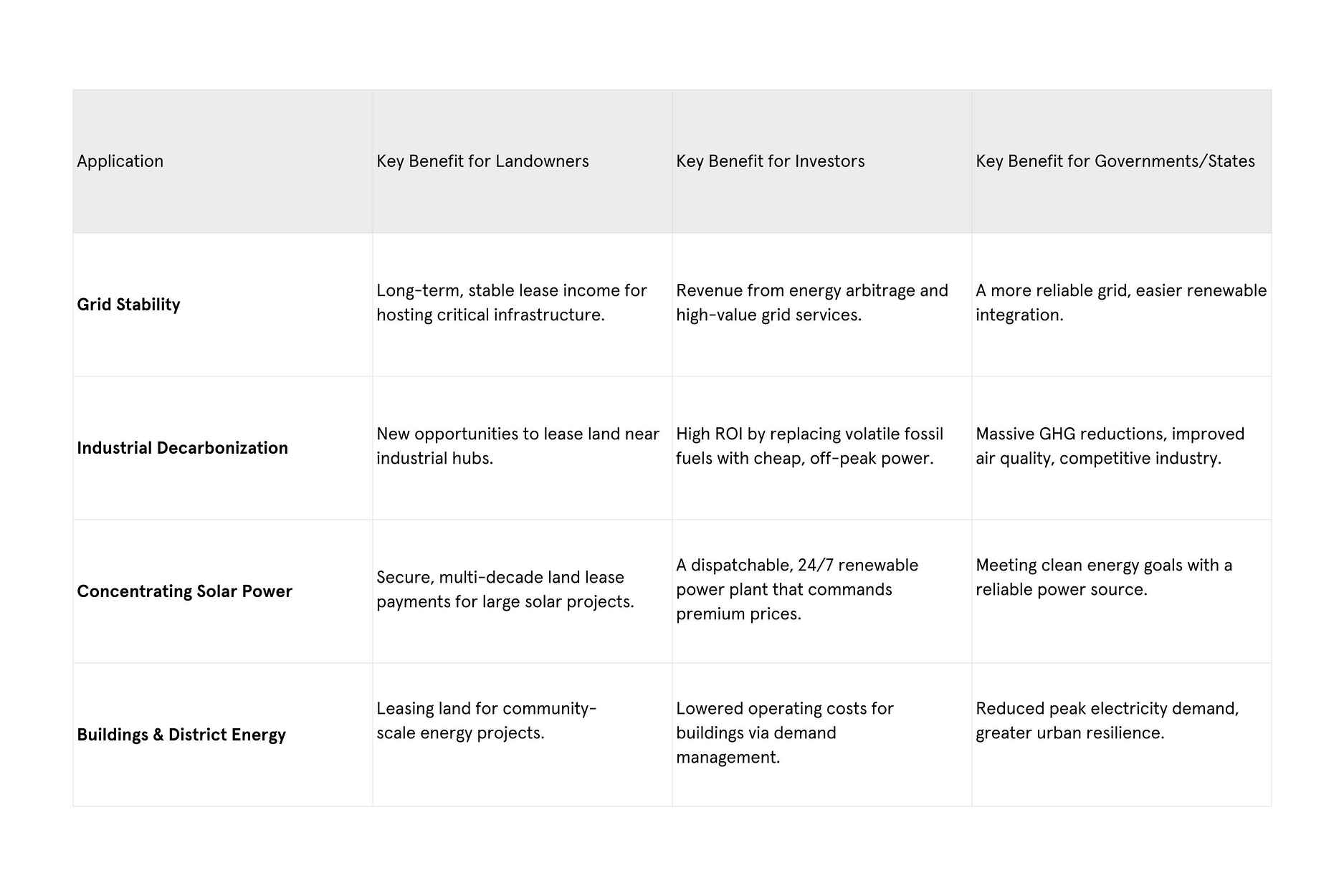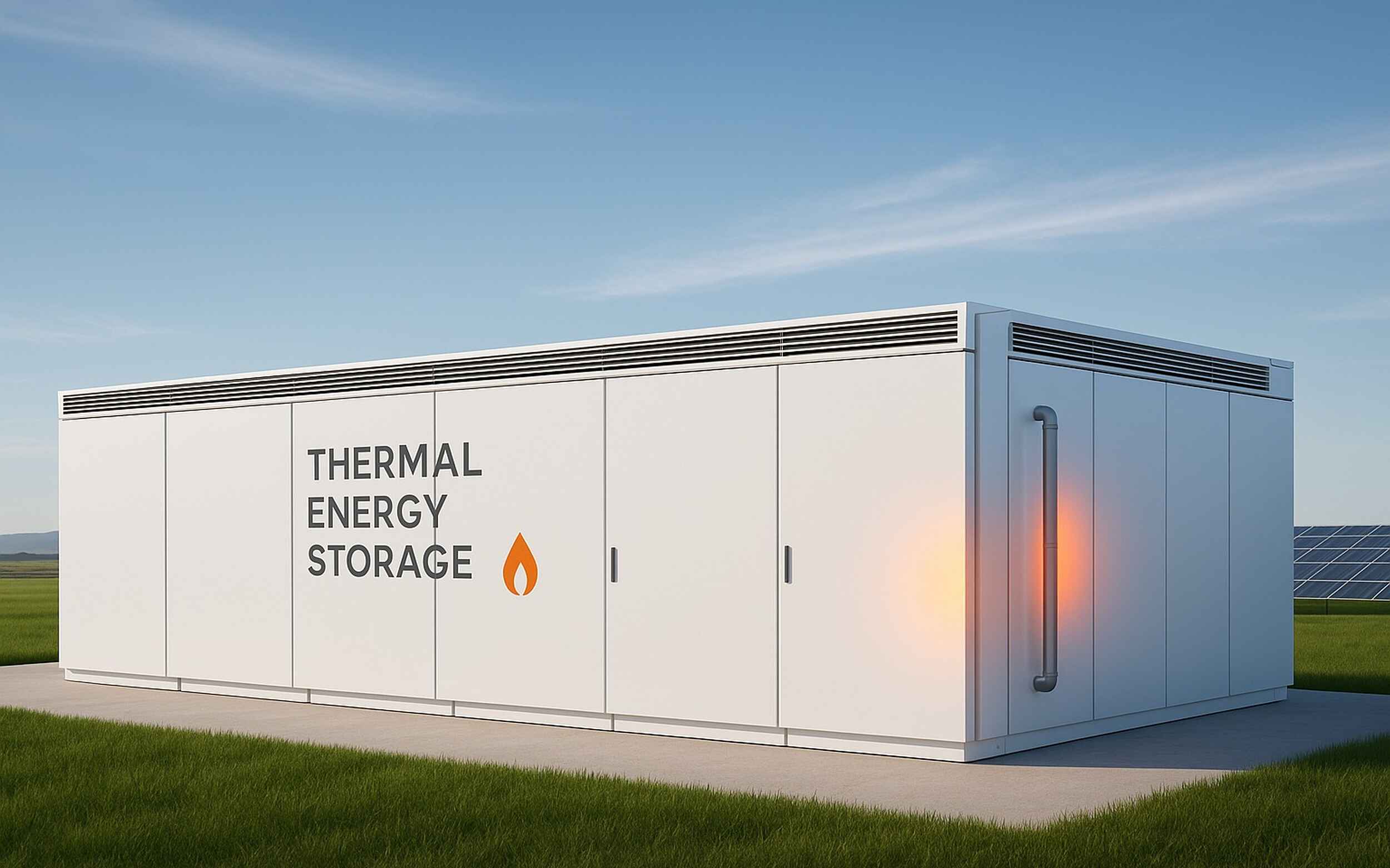The global transition toward a clean energy economy, powered by renewable sources like solar and wind, is well underway. However, these powerful resources present a fundamental operational challenge: intermittency. The sun does not always shine, and the wind does not always blow, creating a temporal mismatch between when energy is produced and when it is consumed. This variability can strain electrical grids and hinder the full-scale integration of renewables.
It’s in such scenarios that thermal energy storage (TES) emerges as a foundational technology. It provides the critical flexibility needed to build a resilient, reliable, and decarbonized energy system. The core value of TES lies in its ability to decouple the moment of energy generation from the moment of use. A helpful way to conceptualize this is as a large-scale 'heat battery'. While a conventional battery stores energy in chemical form, a thermal battery stores it as heat or cold. It captures affordable, abundant renewable power when it is available and dispatches it hours, days, or even seasons later when it is most needed and valuable.
For landowners, investors, and policymakers, a clear understanding of thermal energy storage is essential for unlocking new revenue streams, making sound financial investments, and crafting effective energy policy.
The Fundamentals: How a 'Heat Battery' Operates
At its core, thermal energy storage is a technology designed to stock thermal energy by heating or cooling a storage medium so that the stored energy can be used at a later time. This process is remarkably efficient and can be broken down into a fundamental three-stage cycle.
First, during the charging phase, an energy source is used to change the temperature of the storage medium. This energy can come from various sources, but a common method is to use low-cost or surplus electricity from the grid, often from renewable sources to power a resistive heater that warms the medium. Alternatively, the system can capture concentrated solar energy or recover industrial waste heat that would otherwise be lost. Once charged, the thermal energy is contained within a highly insulated system during the storage phase to minimize heat loss over time. The duration of storage is a key design parameter and can range from several hours to many months. Finally, when the energy is needed, it is extracted from the storage medium in the discharging phase. This can involve running the hot medium through a heat exchanger to produce steam for electricity generation, delivering high-temperature heat directly to an industrial furnace, or circulating hot or chilled water for building climate control.
This simple cycle allows TES to function as a versatile energy management tool, bridging the gap between energy supply and demand.
The Portfolio of Thermal Storage Technologies
Thermal energy storage is not a single technology but a diverse portfolio, with each approach offering unique characteristics and performance profiles. These technologies are broadly classified into three principal categories based on the physical or chemical mechanism used to store energy. For investors and developers, understanding the distinct trade-offs between them is paramount.

Sensible Heat Storage (SHS): The Proven Workhorse
Sensible Heat Storage is the most mature and commercially straightforward form of TES. The principle is simple: energy is stored by raising the temperature of a storage medium, and it is discharged by extracting that heat as the medium cools. The choice of medium is a critical design decision. Water is unparalleled for low-temperature applications due to its low cost and high heat capacity, making it dominant in district heating systems. For high-temperature applications, particularly in Concentrating Solar Power (CSP) plants, molten salts are the industry standard, capable of operating up to 600°C to enable efficient electricity production. The primary challenge with molten salts is their high freezing point, which requires auxiliary heating systems to prevent blockages. A third option involves solid media like rocks, sand, and ceramic bricks. These materials are robust, low-cost, and can withstand extremely high temperatures (over 1,000°C), making them exceptionally well-suited for providing clean, high-grade heat to heavy industry.
Latent Heat Storage (LHS): Harnessing the Power of Phase Change
Latent Heat Storage systems represent a more advanced approach that utilizes Phase Change Materials (PCMs). These substances store and release large amounts of energy as they transition between solid and liquid states. The defining engineering advantage of this process is that this energy transfer occurs at a nearly constant temperature, which allows for more precise thermal control in various applications. The widespread adoption of LHS technology is currently constrained less by the concept and more by significant material science challenges. The primary focus of research and development is on improving the long-term stability of PCMs, as some tend to degrade over repeated freeze/thaw cycles, and enhancing their thermal conductivity to allow for faster charging and discharging. The intellectual property and future growth of the LHS market lie in creating advanced PCMs that overcome these limitations
Thermochemical Storage (TCS): The High-Density Frontier
Thermochemical Storage represents the most advanced and, in many ways, the most transformative category of thermal storage. Unlike SHS and LHS, which store energy as sensible or latent heat, TCS stores energy within the potential of reversible chemical bonds. In this process, high-temperature heat drives an endothermic reaction, breaking a chemical compound into two or more separate products. These products can then be stored at ambient temperature indefinitely with virtually zero energy loss. When energy is needed, the products are recombined in an exothermic reaction, releasing the stored chemical energy as high-temperature heat. This capability for truly long-duration, lossless storage makes TCS a prime candidate for seasonal applications, such as capturing abundant solar energy in the summer and releasing it for heat in the winter. While it is the least mature of the three technologies, TCS holds the promise of unlocking a new level of grid flexibility.
Sector-Specific Applications and Strategic Value
Thermal energy storage is a versatile platform with a wide array of applications that create distinct value for different stakeholders. From stabilizing national power grids to decarbonizing heavy industry, TES is a critical tool for the energy transition.

In Concentrating Solar Power, the integration of TES in molten salt tanks transforms an intermittent solar resource into a dispatchable, baseload renewable power station capable of providing reliable 24/7 power. For the broader electrical grid, TES acts as a powerful stabilizing force by absorbing fluctuating renewable output and releasing it as a smooth, predictable block of power. This enhances grid reliability and resilience.
In the industrial sector, which is one of the most challenging to decarbonize, TES offers a direct and economically compelling pathway to electrify industrial heat. By using low-cost renewable electricity to heat a storage medium like ceramic bricks, TES systems can deliver clean, reliable, high-temperature heat on demand, directly replacing fossil-fueled boilers and furnaces while hedging against volatile fuel prices.
Finally, in the built environment, TES offers a powerful suite of solutions. On a large scale, centralized TES systems can serve as the heart of district heating and cooling networks. For individual commercial buildings, cool-storage systems can dramatically reduce electricity consumption during peak hours. This not only lowers utility bills but also enhances the resilience of our communities.
The Investment Case and Policy Landscape
For investors, the decision to finance a thermal energy storage project hinges on a clear economic rationale. The profitability of a TES asset is often less about the core technology itself and more about the market structure and grid service opportunities in which it operates.
The most crucial concept for maximizing the financial return of a TES project is revenue stacking. Relying on a single value stream significantly limits a project's earning potential. The most successful TES projects are designed to capture multiple revenue streams simultaneously. This includes earning revenue from time-of-use energy arbitrage by charging with low-cost power and discharging when prices are high. For industrial customers, it means generating savings through demand charge reduction. In organized electricity markets, it involves bidding to provide valuable ancillary services like frequency regulation. A sophisticated Energy Management System that can optimize the asset's operation in real-time is key to unlocking this full value.
Supportive government policy plays a decisive role in accelerating deployment. In the United States, the Inflation Reduction Act (IRA) has been particularly impactful. It modified the Investment Tax Credit (ITC) to make it available for standalone energy storage projects for the first time. This provides immense flexibility in project siting and design. The 30% base credit, with potential bonus adders, significantly reduces upfront capital costs and improves project economics. This federal support, combined with state-level procurement targets and incentive programs, is creating powerful tailwinds for the industry.
The Innovation Horizon and Future Outlook
While many TES technologies are mature and commercially available, the path to widespread deployment is paved with continued innovation. The future is being shaped by incremental improvements to existing systems and breakthrough research in next-generation technologies. The research landscape is vibrant, with efforts focused on developing next-generation molten salts that can operate at higher temperatures for greater efficiency, creating nano-enhanced Phase Change Materials with superior stability and heat transfer, and designing advanced thermochemical reactors to unlock the potential of long-duration storage.
This technological progress is translating into a robust market outlook. The global thermal energy storage market is projected to grow substantially, expanding at a compound annual growth rate of over 10% through the end of the decade. This growth is driven by the increasing deployment of renewable energy, the push to decarbonize industrial heat, and supportive government policies.
In conclusion, the transition to a clean energy economy demands a fundamental re-architecting of our energy systems to be more flexible and reliable. Thermal energy storage is not merely an option in this transition; it is an indispensable and versatile technology poised to play a central and expanding role in building the clean, reliable, and prosperous energy future we all envision.
